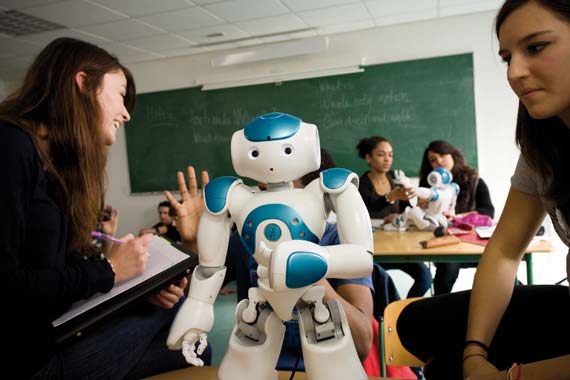 Robotics in Education Kristupas Razas
Robotics in Education Kristupas Razas
Key terms
1. Humanoid robot
– a self-acting machine that is designed to reflect human appearance.
2. Refine – show
deep interest and commitment into a certain subject.
3. Innovation –
adjustment of new technologies into everyday life.
4. Robot development
– making robots more and easier accessible.
5. Effect – to have
a change in something.
6. Aid – help.
Summary
Modern technology advances rapidly altering
the everyday life of citizens around the globe. The change in education is
rather a heavily discussed topic by students, learning facility employees and
even government. The effect is unarguably seen, although it is not always as
incredible as it seems at first. This summary will point out the positive
aspects of subject as well as find the down side of robotics entering the
human-develop realm.
Researchers recently invented a new type of
robotics providing aid in the classrooms of schools and colleges. These include
humanoid robots, drones, machines. Providing the feedback of some of the
teachers, the innovations most definitely help in the learning process, despite
the great benefit, teachers don't forget to express some of the sceptic
approach in order to assist scientists in developing future robots.
The first and most commonly mentioned
advantage is that robots grant an ability to join classrooms for the disabled
children. Many students
struggling with cancer or other terminal illnesses can’t reasonably make it to
class every day, but they shouldn’t have to miss out on the lessons and social
interactions that come with school. The technology allows children to attend
class from afar. These robots can perform various actions, for example waving,
smiling, talking. They make it possible for children to interact with their
friends and teachers from home or hospitals.
The next most favored point is that robots
bring creativity and passion. Working with robots in class one can explore
different learning pathways. The commitment of students grow in subjects that
they never knew they would love. The understanding of leadership,
communication, community involvement, teamwork skills is improved significantly
when learning with help of robots. Adolescents refining the robotics develop
their personalities in general, leading in a more beneficial way of studying
than the regular education system.
Leaving the magnificent amount of pros
behind, teachers claim that robots must be programmed to behave as a students’
learning assistant instead of trying to replace current teachers. Humanoid robots are still a fair way
away from being autonomously situated in schools due mainly to technological
limitations such as inaccurate speech or emotion recognition. However, the
intention of most researchers in robotics is not for robots to replace
teachers. Rather, the design goals of most robots are to function as an aid in
the classroom and to enhance the added value they can bring as a stimulating
and engaging educational tool.
The most
concerning disadvantage of robotics is the expense. To the present day, only a
few selected education facilities are given the chance to test innovations, and
very few children with disabilities or illnesses can take the opportunity to
replace themselves in class. Scientists do their best to make cheaper material
viable for construction, though this will take some time. Hopefully, the robots
will be accessible to more people in the future.
References
1.
Robots in Education: What’s Here and What’s Coming
By Kristen
Hicks - February 9, 2016
2.
Robots likely to be used in classrooms
as learning tools, not teachers
November 6, 2016
8.25pm GMT
3.
Robots and drones take over
classrooms
By Jane Wakefield Technology reporter
4. The Top Five Unexpected
Benefits of Robotics in the Classroom
By Aaron Maurer
– November 8, 2016
5.
Robots in Education and Care of Children with
Developmental Disabilities: A Study on Acceptance by Experienced and Future
Professionals
By Daniela Conti, Santo Di Nuovo, Serafino Buono,
Alessandro Di Nuovo - January, 2017
6.
Exploring the educational potential of
robotics in schools: A systematic review
By Fabiane Barreto Vavassori Benitti
– April, 2012
7.
Robots in the Classroom:
What Are They Good For?
(https://ww2.kqed.org/mindshift/2014/05/27/robots-in-the-classroom-what-are-they-good-for/)